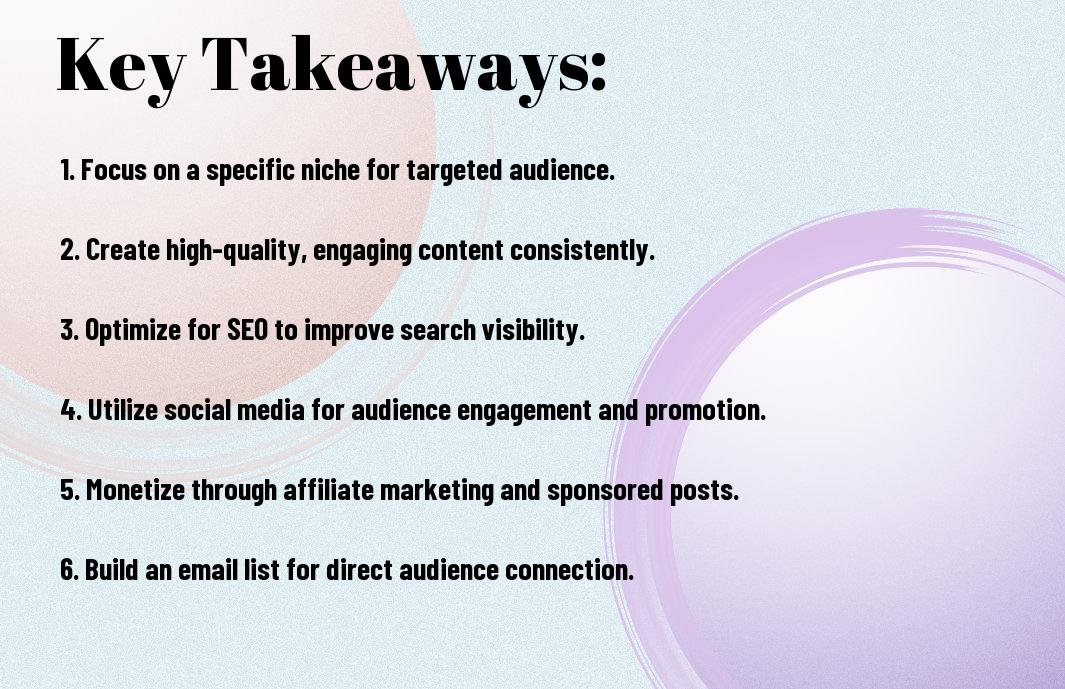Just imagine turning your passion for travel into a profitable venture! With the right strategies, you can transform your travel blog into a source of income while sharing your unique experiences. In this guide, you’ll learn various monetization methods, from affiliate marketing to sponsored posts, that can help you leverage your love for exploration and connect with your audience effectively. Whether you’re a seasoned traveler or just starting out, these insights will empower you to make your travel blog a thriving business.
Key Takeaways:
- Content Quality: Focus on creating engaging and high-quality content that resonates with your audience to build a loyal following.
- Affiliate Marketing: Utilize affiliate marketing by promoting travel-related products and services, earning commissions for referrals.
- Advertising Revenue: Explore opportunities for advertising revenue through sponsored posts or ad placements on your blog.
- Social Media Engagement: Leverage social media platforms to increase your reach and drive traffic to your blog, enhancing visibility and potential income.
- Travel Services: Consider offering travel-related services, such as travel planning or consulting, to diversify your income streams.
Quick recommendation: Our blog is filled with useful tips to help you succeed. If you are seeking a more comprehensive training program, we recommend the 72 Hour Challenge.
Selecting Your Niche
Your travel blog’s success greatly depends on selecting a niche that resonates with both your interests and a specific audience. By honing in on a particular theme, you not only differentiate yourself from the myriad of travel blogs out there, but you also create a brand identity that your readers can connect with. Whether it’s adventure travel, luxury travel, budget backpacking, or family trips, defining your niche sets the foundation for your blog and guides your content strategy moving forward.
Identifying Target Audiences
Besides choosing a niche, pinpointing your target audience is equally important. You need to analyze who would be interested in your blog’s specific topics and tailor your content to meet their needs. Creating personas of your ideal readers gives you insight into their preferences, habits, and pain points, allowing you to produce engaging content that speaks directly to them. This targeted approach increases your blog’s visibility and encourages audience loyalty, which is beneficial when it comes to monetization.
Specializing in Unique Experiences
Above all, specializing in unique experiences can set your travel blog apart from others in the competitive landscape. Consider focusing on niche travel experiences such as eco-tourism, local culinary adventures, or cultural immersions that aren’t typically highlighted in mainstream travel guides. This not only showcases your passion but also attracts a dedicated readership looking for authentic and less-explored travel options. By emphasizing these unique avenues, you create opportunities for partnerships with brands related to those experiences, opening up additional income streams.
In addition, specializing in unique experiences allows you to position yourself as an authority in that niche. You can share in-depth knowledge, insider tips, and personal anecdotes that resonate with your audience. This expertise boosts your credibility and encourages engagement, as readers appreciate content that provides value and insights they can’t find elsewhere. Consequently, as you build a loyal audience around these unique experiences, you’ll find more opportunities for monetization through sponsored posts, affiliate marketing, or even collaborations with travel companies that align with your specialized content.


Building Your Blog
It is imperative to lay a solid foundation when building your travel blog, as this ultimately sets the stage for your success in the industry. You will want to focus on two primary elements: selecting the right platform and designing for user experience. By prioritizing these components, you’ll create an engaging space that encourages visitors to return and interact with your content. This will not only enhance your credibility but also open doors to potential monetization opportunities in the future.
Choosing the Right Platform
For many aspiring travel bloggers, choosing the right platform is vital to successfully managing and growing your blog. Platforms such as WordPress, Wix, or Squarespace offer various features that can simplify your blogging experience while providing you with key customization options. WordPress, in particular, is the most popular choice among bloggers due to its flexibility, extensive plugin options, and the wealth of resources available for support. As you explore different platforms, think about your long-term goals and the technical skills you possess, as this will guide you in making an informed choice.
Designing for User Experience
With an increasing number of readers accessing content from mobile devices, it’s imperative to prioritize user experience when designing your travel blog. This includes ensuring fast loading times, easy navigation, and mobile responsiveness. By creating a visually appealing and organized layout, you can significantly enhance the reader’s experience. Additionally, consider the importance of high-quality images, engaging typography, and clear content hierarchy to create an attractive atmosphere that encourages visitors to explore your blog further.
Understanding user behavior is the key to maximizing engagement on your travel blog. Assess how visitors interact with your site, including how long they stay, which pages they visit, and any points where they lose interest. Utilize tools like Google Analytics to gather data, allowing you to refine your design and content strategy over time. Your goal should be to create a seamless browsing experience where readers can easily find the information they seek while being motivated to share your blog with others.
Quick recommendation: Our blog is filled with useful tips to help you succeed. If you are seeking a more comprehensive training program, we recommend the 72 Hour Challenge.
Creating Compelling Content
After you have set up your travel blog, it’s important to focus on crafting content that resonates with your audience. Compelling content not only draws visitors to your site but also keeps them engaged and encourages them to return. By sharing your unique experiences and insights, you can create a loyal readership eager to follow your journeys. Utilize a variety of mediums, such as blog posts, videos, photos, and infographics, to diversify your content and appeal to different preferences. Keep in mind that quality and originality are the hallmarks of successful travel blogging.
Crafting Engaging Stories
Beside providing information, weaving engaging narratives about your travels will captivate and inspire your audience. Share personal anecdotes, challenges faced during your adventures, and the transformative experiences that travel has brought into your life. Your readers will connect more deeply with real stories versus dry, factual accounts, making it more likely they will interact with your content through comments or shares. Don’t shy away from expressing your emotions or perspectives; this authenticity helps to build a community around your blog.
Utilizing SEO Strategies
Behind every successful travel blog lies a solid understanding of SEO strategies. Ensuring your content is optimized for search engines will drive more organic traffic to your site. Use keyword research tools to identify what potential readers are searching for and incorporate these keywords naturally into your blog posts. Focus on writing captivating headlines, using meta descriptions, and structuring your content for readability, as these elements enhance your blog’s visibility in search engine results.
Understanding SEO is vital for increasing your blog’s reach and visibility. Start by researching keywords relevant to your travel niche—these are terms people type into search engines when looking for information. Use these keywords thoughtfully within your posts, in headings, and image alt tags to help search engines understand your content better. Additionally, investing time in building backlinks from reputable sites can also bolster your site’s authority, further enhancing your chances of ranking higher in search engine results.
Growing Your Audience
Once again, to truly monetize your travel blog, you need to focus on growing your audience. The larger your audience, the more opportunities you have for earning income through sponsored posts, affiliate marketing, and other revenue streams. You can achieve this by consistently delivering valuable content and engaging with your readers. By establishing a compelling brand and using various marketing strategies, you can attract more visitors who are genuinely interested in your niche.
Leveraging Social Media
Above all, utilizing social media platforms is an excellent way to connect with a broader audience. Whether you choose Instagram, Facebook, or Pinterest, these channels allow you to showcase your travel experiences in visually appealing ways. Regularly share updates, behind-the-scenes moments, and travel tips to keep your followers engaged. Don’t forget to interact with your audience by responding to comments and questions, creating a sense of community that encourages sharing and boosts your visibility.
Building an Email List
Along with social media, one of the most effective ways to grow your audience is by building an email list. This allows you to maintain direct communication with your readers, providing updates, exclusive content, and special offers. By offering a freebie, such as a travel guide or checklist, in exchange for their email addresses, you motivate visitors to subscribe. It’s an effective strategy to ensure you reach your audience consistently, regardless of social media algorithm changes.
Even though beginning an email list may seem daunting, it can significantly enhance your connection with your audience. By utilizing email marketing tools, you can easily manage your list and send tailored content to your subscribers. Regular newsletters not only keep your audience informed about your latest blog posts but also allow you to promote affiliate products and sponsored content directly, leading to increased revenue opportunities.
Monetization Strategies
All travel bloggers face the challenge of turning their passion into a profitable venture, but with the right monetization strategies, you can effectively generate income from your blog. By exploring various options, you can leverage your platform to create multiple revenue streams. One of the most effective methods is affiliate marketing, where you promote products or services and earn a commission for every sale made through your referral link. This approach not only provides a financial benefit but also adds value to your audience by recommending resources that can enhance their travel experiences.
Affiliate Marketing
Against the backdrop of your travel blog, affiliate marketing stands out as an ideal way to monetize your content without compromising the trust of your audience. You can partner with travel-related brands and services—such as airlines, accommodation providers, or travel gear companies—by incorporating affiliate links into your posts. Whether you’re writing a review or sharing a personal travel experience, seamlessly embedding these links can lead your readers to make purchases, resulting in transactional income for you.
Sponsored Posts and Partnerships
Sponsored content offers another lucrative opportunity to monetize your travel blog. Sponsored posts involve collaborating with brands that pay you to create content around their products or services, often providing exposure to a targeted audience that aligns with their brand. This form of partnership not only benefits you financially but also enables you to provide your audience with insights into various products range, enhancing their travel experiences.
And by forging strong partnerships with brands, you can tap into not only sponsored posts but also long-term collaborations that can lead to additional promotion across their channels. Engaging in these partnerships ensures that you have access to exclusive offers, discounts, and opportunities to participate in joint adventures that can captivate your audience, ultimately driving more traffic to your site and earning potential. The key is to align your brand values with those of your partners to maintain authenticity and credibility with your readership.
Networking and Collaboration
Many travel bloggers often overlook the power of networking and collaboration when it comes to monetizing their blogs. Building relationships with fellow bloggers not only enhances your visibility but also opens doors to unique opportunities. By connecting with others in your niche, you can share insights, exchange tips, and receive support for your endeavors. Engaging actively in communities—whether online or offline—means you are a part of a collective effort that benefits everyone involved. Attend travel conferences, participate in social media groups, and consider guest posting on each other’s platforms to establish mutually beneficial connections.
Connecting with Other Bloggers
After immersing yourself in the travel blogging community, you will find it crucial to connect with other bloggers who share your passion. This camaraderie can lead to valuable partnerships, where you can collaborate on guest posts, social media promotions, and even joint ventures like travel challenges or shared itineraries. By engaging in discussions and offering assistance, you can forge lasting relationships that can help strengthen your brand and increase your reach.
Engaging with Industry Brands
On the path to monetizing your travel blog, you will also want to engage with industry brands. Establishing relationships with companies that align with your niche can lead to sponsorships, affiliate marketing opportunities, and brand ambassadorships. This is not only about promoting products; it’s about offering authentic experiences and insights that resonate with your audience. When brands see that you have built a loyal following and a genuine voice, they are more likely to collaborate with you, which in turn provides you with a revenue stream.
Bloggers often find success by actively reaching out to brands that are a good fit for their audience. Create a professional media kit showcasing your blog’s statistics, audience demographics, and previous partnerships to present to potential collaborators. Additionally, engage with brands on social media and attend relevant events where you can meet representatives in person. This proactive approach can yield fruitful collaborations that benefit both your blog and the brands involved.
Summing up
The journey of monetizing your travel blog can be both exciting and rewarding. By providing valuable content, engaging with your audience, and strategically leveraging various income streams like affiliate marketing, sponsored posts, and online courses, you can create a sustainable source of income. Each step you take enhances not only your blog’s visibility but also your personal brand as a travel content creator.
It’s vital to stay authentic and true to your experiences as you navigate through different monetization methods. Your unique voice and perspective will resonate with your readers, building a loyal following over time. As you continue to refine your skills, adapt to industry trends, and align your strategies with your audience’s interests, you will be well on your way to making your travel blog a profitable venture while sharing your passion for exploration.
Quick recommendation: Our blog is filled with useful tips to help you succeed. If you are seeking a more comprehensive training program, we recommend the 72 Hour Challenge.

